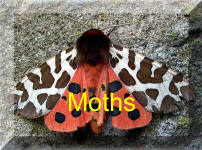ABH 70.243
Swallow-tailed
Moth Ourapteryx sambucaria
BF 1922
Back To
(Linnaeus, 1758)
Phenology
JAN
FEB
MAR
APR
MAY
JUN
JUL
AUG
SEP
OCT
NOV
DEC
Family
Geometridae » Ennominae
Wingspan
40-50 mm.
Description
Adults are akin to large butterflies
and named after the small projections on the apex of the hind wings.
Most adults trapped at light show signs of damage and appear faded.
The bright lemon yellow so distinctive of fresh specimens fades
quickly. Adults have two widely spaced cross-lines on the forewings.Being
strictly nocturnal and having quite a short emergence period in
July, it is not often seen by casual observer.
Life Cycle
The larvae feed
on a number of trees and shrubs, but prefer ivy (Hedera helix).
Habitat
Frequently found in a variety of habitats
particularly woodland rides, clearings, bogs and gardens, but never
abundantly. Adults have a skittish nature and often fly at the least
sign of disturbance. The larvae can be found from August to May of
the following year on ivy and various other species of trees and shrubs
Larva feeds on woody plants such as Blackthorn, Hawthorn, Goat Willow,
Black Currant, Elder, Horse Chestnut and Ivy.. It overwinters as a
larva.
Links
Images
ABH 70.243 |
Swallow-tailed Moth Ourapteryx sambucaria |
BF 1922 |
|||||||||||||
|
|
|||||||||||||||
| Back To | (Linnaeus, 1758) |
||||||||||||||
|
|||||||||||||||
Phenology |
|
||||||||||||||
Family |
Geometridae » Ennominae | ||||||||||||||
Wingspan |
40-50 mm. | ||||||||||||||
Description |
Adults are akin to large butterflies
and named after the small projections on the apex of the hind wings.
Most adults trapped at light show signs of damage and appear faded.
The bright lemon yellow so distinctive of fresh specimens fades
quickly. Adults have two widely spaced cross-lines on the forewings.Being
strictly nocturnal and having quite a short emergence period in
July, it is not often seen by casual observer. |
||||||||||||||
Life Cycle |
The larvae feed on a number of trees and shrubs, but prefer ivy (Hedera helix). | ||||||||||||||
Habitat |
Frequently found in a variety of habitats particularly woodland rides, clearings, bogs and gardens, but never abundantly. Adults have a skittish nature and often fly at the least sign of disturbance. The larvae can be found from August to May of the following year on ivy and various other species of trees and shrubs Larva feeds on woody plants such as Blackthorn, Hawthorn, Goat Willow, Black Currant, Elder, Horse Chestnut and Ivy.. It overwinters as a larva. | ||||||||||||||
Links |
|
||||||||||||||
Images |
|||||||||||||||
|
|
|||||||||||||||


